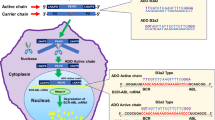Abstract
Objective: To study the differences and similarities of the antisense drugs with different structures on the biological functions of K562 cells. Methods: Cytotoxic effects were measured by use of a cell viability assay. Flow cytometric analysis and agarose gel electrophoresis of DNA fragmentation were also performed. The expression level of protein was assayed by immunofluorescence using fluoresce isothiocyanate label. Results: PNA targeting the coding region of the Bcl-2 messenger RNA could effectively inhibit K562 cell viability, down-regulate the synthesis of the Bcl-2 protein and increase cell apoptosis. By 72 h after the Bcl-2 antisense PNA treatment, K562 cells showed more reduction in the level of Bcl-2 protein compared with cells treated with the antisense ODN. After treatment with 10 µmol/L of Bcl-2 antisense PNA or antisense ODN for 72 h, apoptotic rates of K562 cells were 13.15±1.13 and 11.72±1.12, respectively. Furthermore, there was significant difference in the percentage of apoptotic cells between antisense PNA group and antisense ODN group. Conclusion: The results suggest that antisense PNA targeting the coding region of Bcl-2 mRNA has better antisense effects than the antisense oligonucleotides on inducing apoptosis of K562 cells.
Similar content being viewed by others
References
Kirkland MA, Obrien SG, Goldman JM. Antisense therapeutics in haematological malignancies[J]. Br J Haematol 1994; 87: 447–52.
Reed JC, Stein C, Subasingle C, et al. Antisense-mediated inhibition of Bcl-2 protooncogene expression and leukemic cell growth and survival: comparisons of phosphodiester and phosphorothioate oligodeoxy-nucleotides[J]. Cancer Res 1990; 50: 6565–70.
Bilim V, Kasahara T, Noboru H, et al. Caspase involved synergistic cytotoxicity of Bcl-2 antisense olignoculeotides and adriamycin on transitional cell cancer cells[J]. Cancer Lett 2000; 155: 191–8.
Doyle DF, Braasch DA, Simmons CG, et al. Inhibition of gene expression inside cells by peptide nucleic acids: effect of mRNA target sequence, mismatched bases, and PNA length[J]. Biochemistry 2001; 40: 53–64.
Lei XY, Zhang H. Effect of Bcl-2 antisense oligonucleotide targeting different region of Bcl-2 mRNA on drug-sensitivity of leukemia cells[J]. Chin J Pharmacol Ther 2001; 6: 1–4.
Lei XY, Zhang H, He DM. Bcl-2 antisense oligodeoxynucelotide enhances araninosyl cytosine-induced apoptosis of primary leukemia cells[J]. Chin J Cancer 2002; 21:1301–4.
Miayake H, Tolcher A, Gleave ME. Chemo- sensitization and delayed androgen-independent recurrence of prostate cancer with the use of antisense Bcl-2 oligodeoxy-nucleotides[J]. J Natl Cancer Inst 2000; 92: 34–41.
Wang J, Liu X, Jiang W. Co-transfection of MRP and Bcl-2 antisense S-oligodeoxynucleotides reduces drug resistance in cisplatin-resistant lung cancer cells[J]. Chin Med J 2000; 113: 957–60.
Malchere C, Verheijen J, van der Laan S, et al. A short phospphodiester window is sufficient to direct RNase H-dependent RNA cleavage by antisense peptide nucleic acid[J]. Antisense Nucleic Acid Drug Dev 2000; 10: 463–8.
Pooga M, Langel U. Targeting of cancer-related proteins with PNA oligomers[J]. Curr Cancer Drug Targets 2001; 1: 231–9.
Author information
Authors and Affiliations
Corresponding author
Additional information
Foundation item: This work was supported by the Key Foundation of Science & Technology Program of Guangzhou (No.2001-Z-037-01), and the Nature Science Key Foundation of Guangdong Province (No. 021195).
Biography: LEI Xiao-yong(1970–), male, associate professor, doctor of medicine, Institute of Pharmacy and Pharmacology, Nanhua University, majors in tumor pharmacology.
Rights and permissions
About this article
Cite this article
Lei, Xy., Zhang, H. & He, Dm. Effect of BcL-2 antisense drug with different structure on the biological function of K562 cells. Chin. J. Cancer Res. 16, 109–112 (2004). https://doi.org/10.1007/s11670-004-0007-9
Received:
Accepted:
Issue Date:
DOI: https://doi.org/10.1007/s11670-004-0007-9




